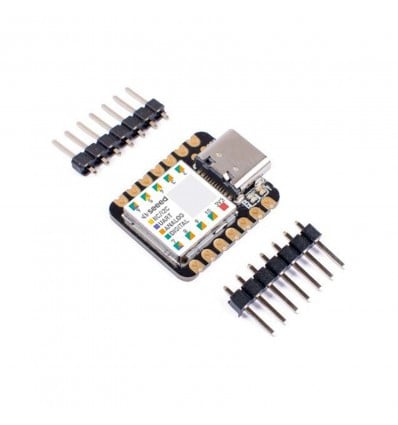International shipping Secure payment
No products
Prices are tax included
Product successfully added to your shopping cart
There are 0 items in your cart. There is 1 item in your cart.
The Seeeduino XIAO SAMD21 is one of the tiniest yet powerful microcontrollers we’ve ever seen, built for advanced users but simplified for everyone.
This product is no longer in stock
Free shipping on orders over R1250 - courier delivery and within South Africa
Whether you’re a master of electron-wrangling or are still just learning the ropes on how to herd your electrons the right way, there’s never a dull moment when it comes to learning about Electronics, especially when it comes to actually putting that knowledge into practice. This is why we’re always excited to get in fresh new microcontrollers like the Seeeduino XIAO SAMD21 MCU, as these kinds of microcontrollers allow us even more freedom to build the projects that we really want to make, without having to compromise on power, functionality or other handy features that you’ve learned to love from Arduino and other popular boards.
When comparing the Seeeduino XIAO to Arduino Boards, it quickly becomes obvious that the XIAO, despite being extremely tiny in size, is actually quite the powerhouse, offering higher clock speeds than many alternatives while fitting a small mountain-load of functionality into a form factor just a little bit bigger than a WiFi or Bluetooth dongle. However, it must be noted that this board doesn’t quite offer the same vast number of ports that many Development Platforms offer, but with a clock speed of 48MHz, built in DAC and ADC functionality, versatile Digital/Analog Pins with PWM capabilities, as well as a host of other features, the Seeeduino XIAO is certainly more than capable of handling an exceptional number of different projects.
Seeeduino XIAO SAMD21 MCU - Technical Specifications: |
|
|
|
|
– SAMD21G18 32bit 48MHz |
|
– 3.3V DC |
|
– 3.3V via 3V3 Pin – 3.3V via VIN/GND Pads (Battery) – 5V via VCC Pin – 5V via USB Type-C |
|
– 11 |
|
– 11 |
|
– 11 |
|
– 3.3V |
|
– 10 (D1/A1 to D10/A10) |
|
– 1 (D0/A0) |
|
– 10-bit – 0 to 1023 Translates to 0V - 3.3V |
|
– Up to 20 |
|
– 8-bit | 10-bit | 12-bit – 0 to 4095 translates to 0V to 3.3V |
|
– 1 (Pins 4 & 5) |
|
– 1 (Pins 8, 9 & 10) |
|
– 1 (Pins 6 & 7) |
|
– Review Pages 1083 to 1085 of Datasheet – Variant A: Pin Cluster Characteristics |
|
– 256KB |
|
– 32KB |
|
– 48MHz |
|
– 32.768KHz |
|
– USB Type-C |
|
– SWD Bonding Pads |
|
– 1 x General Purpose LED – 1 x Power Status LED – 2 x Tx/Rx Status LEDs |
|
– 20 x 17.5 x 3.5mm |
Typical Applications for Seeeduino XIAO SAMD21 Microcontroller:
Although the large majority of microcontrollers are complex in nature and typically capable of so much more than what Makers even use them for, that’s really where the true beauty of general purpose computing is most beneficial, as this level of complexity makes it extremely diverse and ready to offer more than any single Maker could event from a tiny low cost MCU. However, when looking at the Seeeduino XIAO, it’s easy to see that extra time and effort went into making this as user friendly and versatile as well, simplifying all of those complexities and allowing users to simply interface with the microcontroller via Arduino IDE or similar types of development environments.
These features of course make it a great option for hundreds or possibly even thousands of different projects, and given the tiny size of this module, you can expect to be able to squeeze this MCU into almost any project you’re working on, whether you’re building a colourful PingPong LED Array or your own custom smart watch. Additionally, with extra features like the battery solder pads and castellated GPIO pads, coupled with the surprisingly low price, you can easily imagine these boards being installed in tight spaces or even on top of other modules as SMD expansions, lending themselves well to not only Wearable Tech’, but also for a wide range of general purpose applications where space is limited but you still want a good level of power and functionality.
Additional Resources:
- For better insights provided directly by the awesome creators of these modules, be sure to check out the SeeedStudio Seeeduino XIAO Wiki Page, which contains further information, handy resources, getting started tips, as well as sample code to help you get started with this beautiful, compact microcontroller.
Finally, if you want a more visual demonstration of this awesome little microcontroller, take a look through the following video by DroneBot Workshop, which details many of the cool features and the surprising level of functionality that this board offers:
No customer reviews for the moment.








